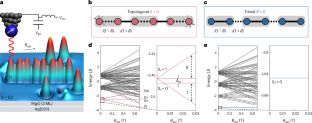利用表面原子自旋构建拓扑量子磁体
IF 38.1
1区 材料科学
Q1 MATERIALS SCIENCE, MULTIDISCIPLINARY
引用次数: 0
摘要
人工量子系统已成为以良好控制方式实现拓扑物质的平台。迄今为止,实验主要探索的是非相互作用拓扑态,而在原子分辨率的固态平台上实现多体拓扑相仍具有挑战性。在这里,我们通过扫描隧道显微镜,在绝缘氧化镁薄膜上将自旋 1/2 的钛原子组装成自旋链和二维自旋阵列,从而构建了拓扑量子海森堡自旋晶格。我们设计了量子自旋模型的拓扑和琐相,从而实现了一阶和二阶拓扑量子磁体。我们通过单原子电子自旋共振探测量子磁体的多体激发,能量分辨率优于 100 neV。利用扫描隧道显微镜尖端的原子局部磁场,我们观察到了各种多体拓扑束缚模式,包括拓扑边缘态、拓扑缺陷和高阶角模式。我们的研究结果为模拟相互作用自旋的奇异量子多体相提供了一种自下而上的方法。本文章由计算机程序翻译,如有差异,请以英文原文为准。


Construction of topological quantum magnets from atomic spins on surfaces
Artificial quantum systems have emerged as platforms to realize topological matter in a well-controlled manner. So far, experiments have mostly explored non-interacting topological states, and the realization of many-body topological phases in solid-state platforms with atomic resolution has remained challenging. Here we construct topological quantum Heisenberg spin lattices by assembling spin chains and two-dimensional spin arrays from spin-1/2 Ti atoms on an insulating MgO film in a scanning tunnelling microscope. We engineer both topological and trivial phases of the quantum spin model and thereby realize first- and second-order topological quantum magnets. We probe the many-body excitations of the quantum magnets by single-atom electron spin resonance with an energy resolution better than 100 neV. Making use of the atomically localized magnetic field of the scanning tunnelling microscope tip, we visualize various many-body topological bound modes including topological edge states, topological defects and higher-order corner modes. Our results provide a bottom-up approach for the simulation of exotic quantum many-body phases of interacting spins. Atom manipulation in a scanning tunnelling microscope allows the fabrication of artificial topological quantum magnets. Single-atom electron spin resonance experiments probe the many-body topological modes of the quantum magnets and provide a visualization.
求助全文
通过发布文献求助,成功后即可免费获取论文全文。
去求助
来源期刊

Nature nanotechnology
工程技术-材料科学:综合
CiteScore
59.70
自引率
0.80%
发文量
196
审稿时长
4-8 weeks
期刊介绍:
Nature Nanotechnology is a prestigious journal that publishes high-quality papers in various areas of nanoscience and nanotechnology. The journal focuses on the design, characterization, and production of structures, devices, and systems that manipulate and control materials at atomic, molecular, and macromolecular scales. It encompasses both bottom-up and top-down approaches, as well as their combinations.
Furthermore, Nature Nanotechnology fosters the exchange of ideas among researchers from diverse disciplines such as chemistry, physics, material science, biomedical research, engineering, and more. It promotes collaboration at the forefront of this multidisciplinary field. The journal covers a wide range of topics, from fundamental research in physics, chemistry, and biology, including computational work and simulations, to the development of innovative devices and technologies for various industrial sectors such as information technology, medicine, manufacturing, high-performance materials, energy, and environmental technologies. It includes coverage of organic, inorganic, and hybrid materials.
 求助内容:
求助内容: 应助结果提醒方式:
应助结果提醒方式:


